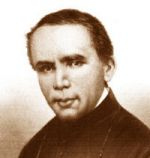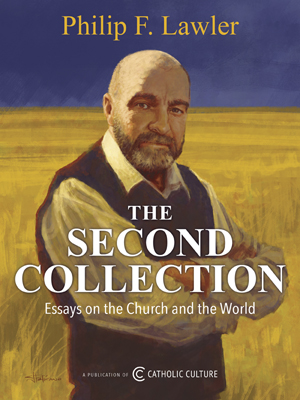Make your gift today!
Help keep Catholics around the world educated and informed.
Already donated? Log in to stop seeing these donation pop-ups.
Catholic Activity: Religion in the Home for Preschool: July
This section for the month of July covers the following areas:
VISITS TO CHURCH: Visitation, July 2nd. LESSON—The Visitation THINGS TO DO: Play about the Visitation VIRTUE FOR PARENTS: Seeing God in nature. PEDAGOGY: Christian Use of Pictures BOOKS FOR THE MONTH: Perez the Mouse, Parent and Child. HYMN FOR THE MONTH: The Magnificat
DIRECTIONS
REMINDER FOR THE YEAR We learn to pray by praying.
REVIEW Prayers to be said daily:—
Morning Offering. Good-night prayers. Grace at meals. Hail Mary. Home-made morning and night prayers. Love and "Thank You" prayers.VISITS TO CHURCH
On July 2nd, the Visitation, [Editor's Note: The feast of the Visitation is May 31.] mother should try to take the little one to church to visit Jesus and Blessed Lady.
LESSON—THE VISITATION
- Tell the story of the Visitation, connecting it with the Annunciation. Read over the March section which treats these subjects in some detail and also review the hints on story-telling.
- If the child is four years old, emphasize our Lady's kindness—telling how she walks miles over the hills to go to see her Cousin Elizabeth who needs her. Speak about kindness to relatives and friends, and if possible take the child on a visit of kindness to an invalid or a cripple. Explain that you are copying Blessed Lady.
- Say the Magnificat at prayer time before the altar. The words can be found in the New Testament, St. Luke, Chapter I, verses 46 to 55.
If your child plays with other little ones, or if you have three of your own, arrange a play about the Visitation. Our Lady, St. Joseph and St. Elizabeth are the actors, and the children can make up the story of a long, hard journey and a pleasant visit. When St. Elizabeth greets Mary, our Lady breaks into song, the wonderful Magnificat.
VIRTUE FOR PARENTS
Seeing God in nature. If parents go out into the woods and fields or to the seashore, they should keep reminding themselves and telling the little one that all these lovely places are made by God for us because He loves us. When you pick a wild flower, say, "What a pretty flower! Dear Jesus made it for us."
NEWS FROM OTHER PARENTS
A father tells us that his baby of three years had a holy picture showing an altar, with an open tabernacle and our Lord standing on the altar steps holding up a Sacred Host. The mother had pointed out the altar, the figure of Jesus and the Host. Several weeks later the father took the child to church to make a visit on a Sunday afternoon. As they went up the middle aisle the little one started to run, pointing to the altar and calling, "Jesus, Jesus, come out to me."
PEDAGOGY
Since we are continually mentioning pictures, it may be well to consider fully their use..1
From the earliest days of Christianity art was used to help teach the Faith. The museums of Europe and all the old churches and cathedrals are full of the works produced from the early days down to the sixteenth century. (After the Protestant revolt, in some places great Catholic art was destroyed; in others it suffered a set-back.) Because paintings on canvas or those frescoed onto the walls of churches did not always retain their original bright colors (often being ruined by dampness), in some places the pictures were made in mosaics, a process in which a design is created by fitting many, many tiny pieces of marble together. The stained-glass windows of the Middle Ages were pictures in glass, set up into the walls to teach religion to the people. And indeed the cathedrals of Europe we might call pictures in stone, carved all over as they were with scenes from the life of Christ and the Old Testament. The greatest artists spent their lives producing paintings, frescoes, mosaics, windows, and buildings which are still so beautiful that modern people are struck dumb with wonder when they see them.
In the superb cathedral of Monreale, near Palermo, Sicily, you can see spread out before you mosaics covering every inch of the wall space, showing the history of religion from Adam and Eve down through the life of Christ.
The educational value of the picture is enormous. Of that there can be no doubt. Today the magazine makers and the movie producers know how to teach every sort of lesson by pictures, some good lessons, but often, alas! evil lessons.
Shall we Catholic parents lag behind and fail to make use of such a powerful means of instruction? Shall we not introduce our own beloved children to that world of religion and beauty revealed in the thousands of Catholic masterpieces created through the centuries?
The careful study of even one of the great religious works of art can give a child an impression which it would take many words to produce. And such an impression remains in the memory to be recalled even in later years.
Prints, copies of great pictures, can be obtained from several firms which specialize in these reproductions. Names of three picture-publishers mentioned in the February section are repeated in footnote two.2
Young children, from two years up, enjoy looking at pictures and naming every person and object in sight. Train the little one to pick out the important person first, usually our Lord. Then ask, "What is dear Lord Jesus doing?" The answer will, of course, depend upon the child's age. You can then tell the story of the picture, following the suggestions on story-telling given in the March section. If the child is interested, let him go on to pick out details. Some young children will notice even tiny flowers in the grass.
Let us, then, try to have at least one picture suitable to the month. Use it on the family altar. And let the child paste it in his scrapbook.
Pay no attention to those who want only pictures of flowers or fruit or sailboats hanging on the wall. The most cultured, the best educated, have in their homes copies of the great religious masterpieces. The wealthy outbid one another to buy the originals, sometimes paying a half million dollars for one picture.
During the nineteenth century there were printed many inartistic religious pictures, some of which are still on sale. Try to avoid them. Have your children get their religious impressions from the great beautiful pictures that generations have loved. It is sad indeed that sometimes children associate religious ideas with ugly or commonplace pictures. Fortunately there is growing up today a new school of artists, who are creating religious pictures in a modern style, which is also very fine art.
BOOKS FOR THE MONTH
Perez the Mouse3 is a very small book all about a little boy king and how he learns that he must be big brother to the poor. The story is a Spanish fairy-tale.
For the parents desirous of studying the subject of education in the home, we recommend a very solid volume based on experimental psychology,—Parent and Child.4
HYMN FOR THE MONTH
The Magnificat should be sung, if possible, during this month of the Visitation. It is to be found with Latin words in the Catholic Youth''s Hymn Book5 and the St. Gregory Hymnal.6
1In the August section for parents of Elementary school children we take up this matter also.
2 University Prints, Newton, Mass. Ars Sacra, New York, N. Y. Thomas Nelson & Sons. [Editor's Note: These companies are no longer in operation. Be creative in where you can find various sources for beautiful artwork. To start, the National Gallery of Art (www.nga.gov) sells postcards and posters of various art. Keep the religious calendars, clip Christmas cards. Go to local museums to see if they sell items, and buy used books that you can clip out the art.]
3 Perez the Mouse, by Padre Louis Coloma and Lady Moreton. New York: Dodd, Mead & Co. [Editor's Note: Although out-of-print, you may be able to find this Spanish legend in a collection of fairy tales from foreign countries.]
4 Parent and Child, by Edgar Schmiedeler, O.S.B., S.T.L., Ph.D., and M. Rosa McDonough, Ph.D., New York: D. Appleton-Century Co.
5 The Catholic Church Hymnal (edited by Tozer). Hymn No. 95. New York: J. Fischer & Bro. [Editor's Note: This hymnal is out of print. A good basic hymnal for a Catholic family is the Adoremus Hymnal, available from www.adoremus.org. I highly recommend the Organ edition (for $24.95) so that one can accompany the song on the piano, plus the CDs can help those in need of more musical help. Another recommendation is Cantate et Iubilate Deo published by the Midwest Theological Forum. --JGM]
6 St. Gregory Hymnal, Singers' Edition. No. 216. Philadelphia: St. Gregory Guild. [Editor's Note: This is now available in two editions. GIA Publications, www.giamusic.com, St. Gregory Hymnal and Catholic Choir Book Compiled by C. T. Andrews, 1979 abridged edition of the original collection edited by N. A. Montani. For 2 and 4 Voice Choirs. Paperback G-2291 8.50, Paperback Spiral bound G-2291-S 9.50. Also, reprint of the original by The Neumann Press, RR2 Box 30, Long Prairie, MN 56347, 800-746-2521, www.neumannpress. for $38.00. --JGM]
Activity Source: Religion in the Home: Monthly Aids for the Parents of Pre-School Children by Katherine Delmonico Byles, Paulist Press, 1938






